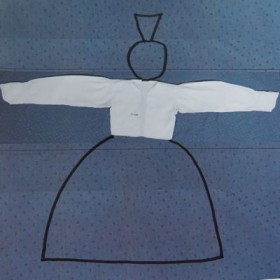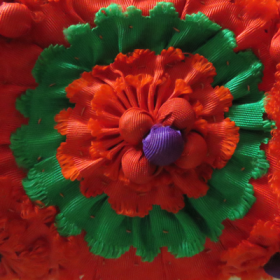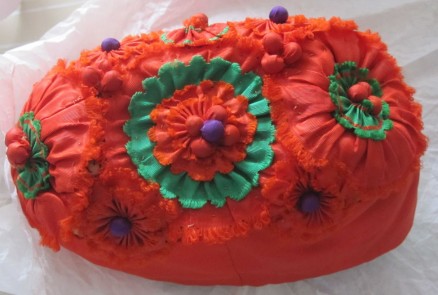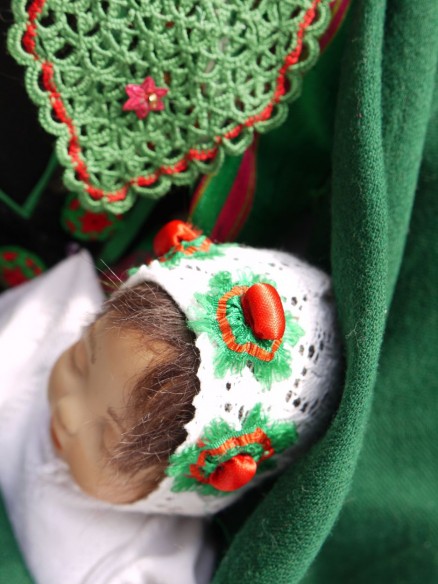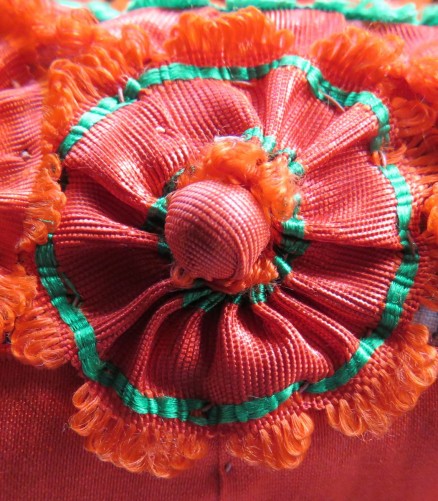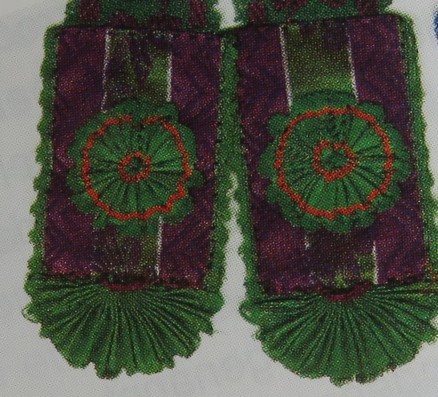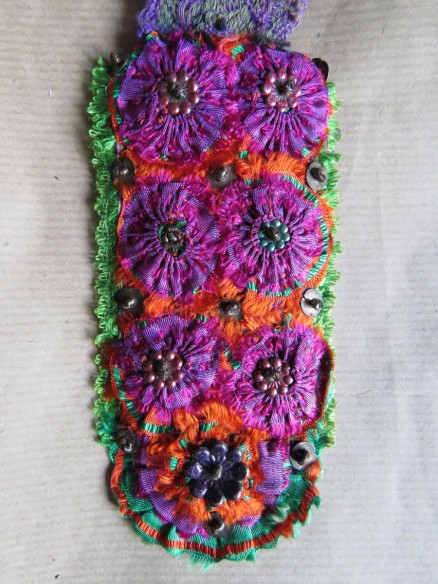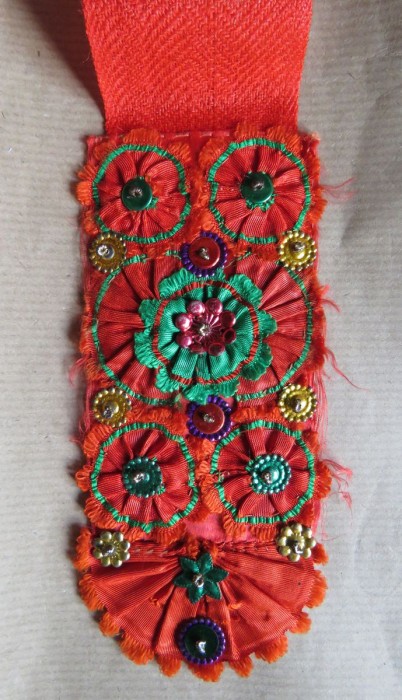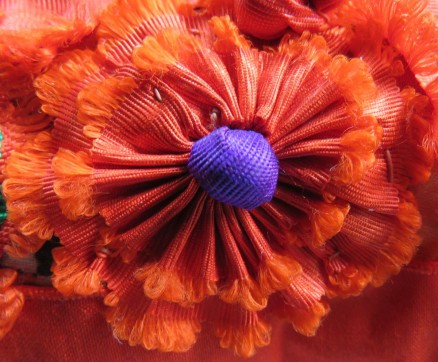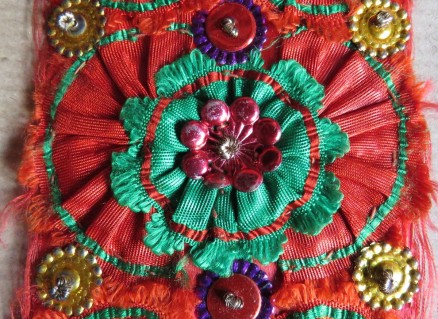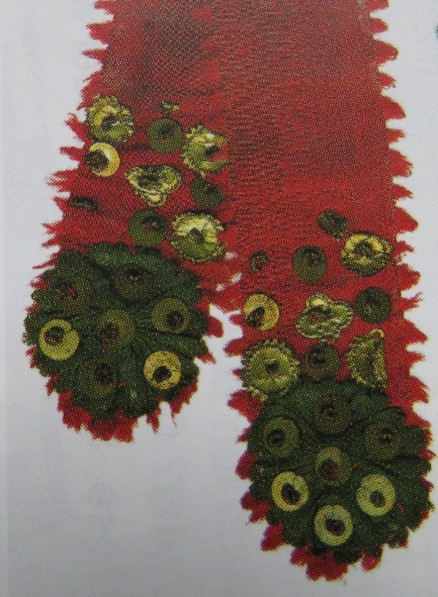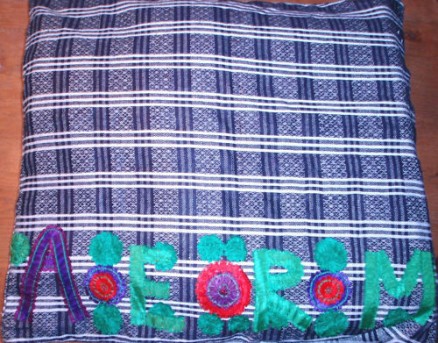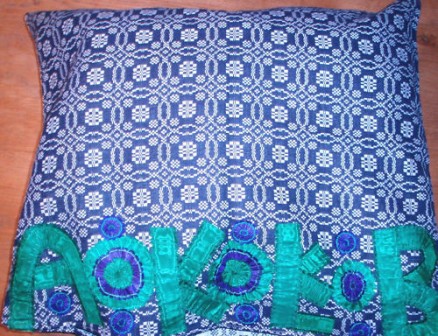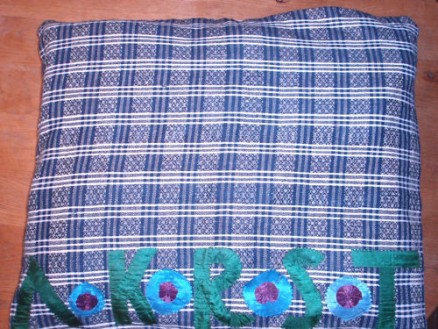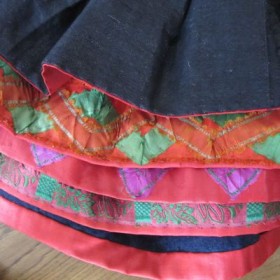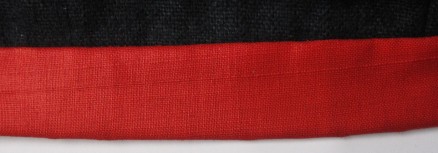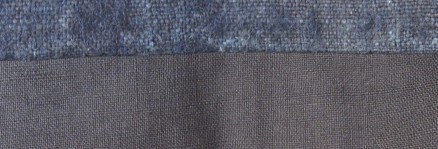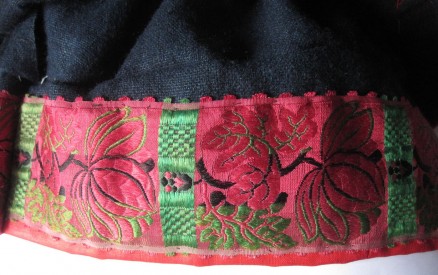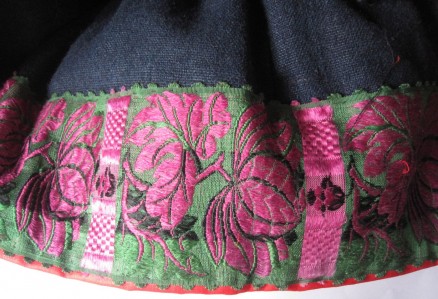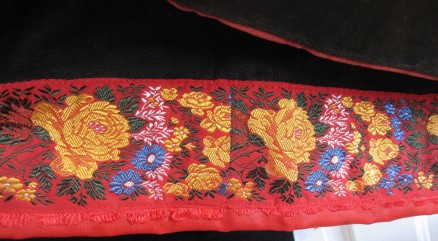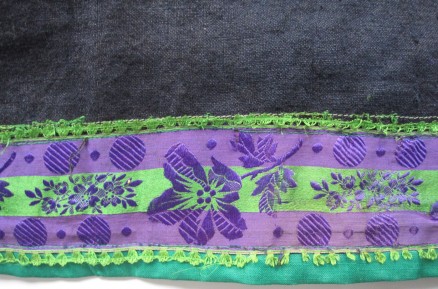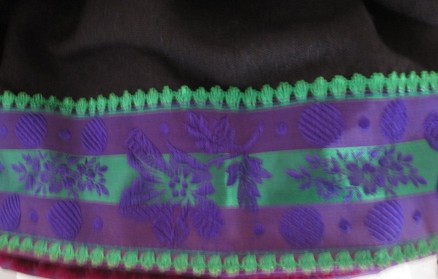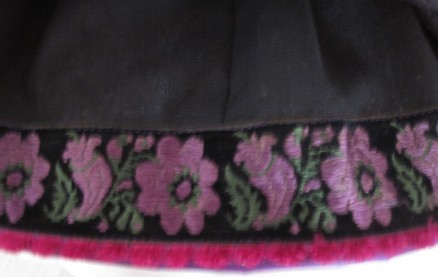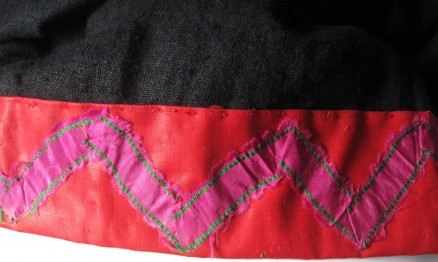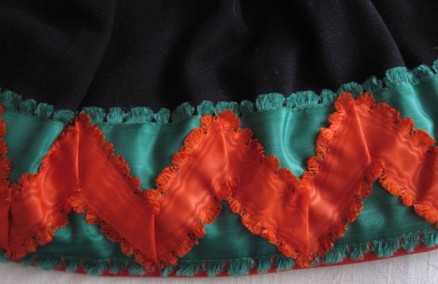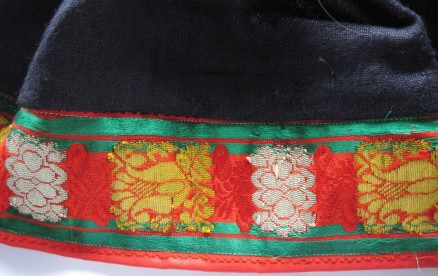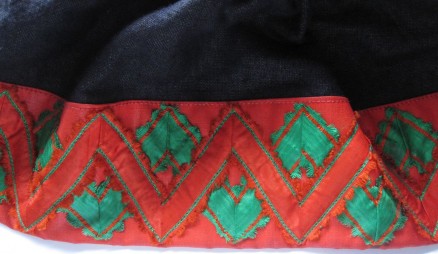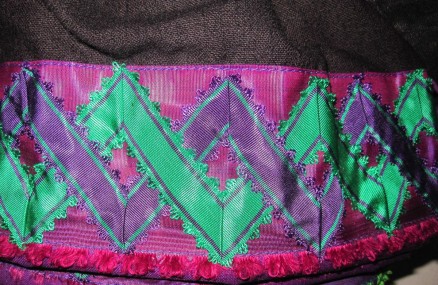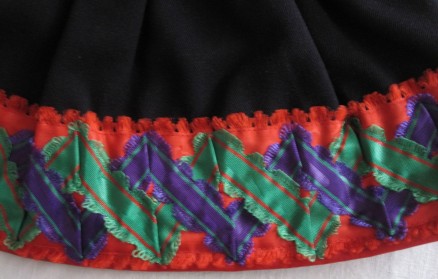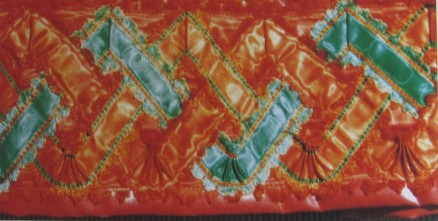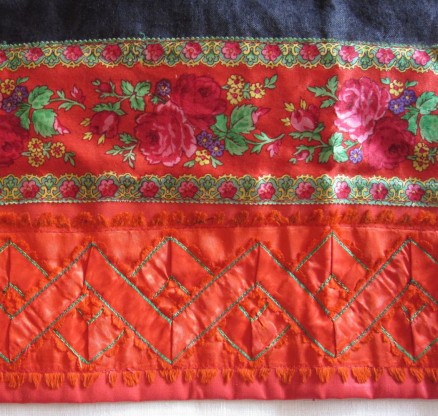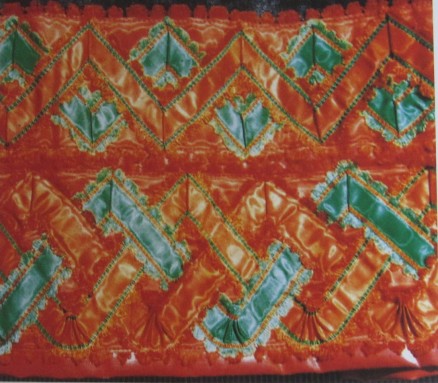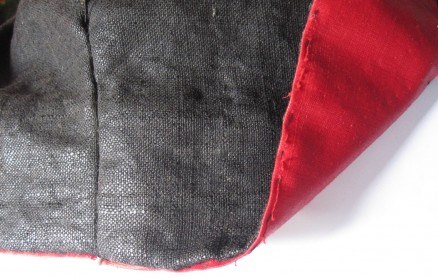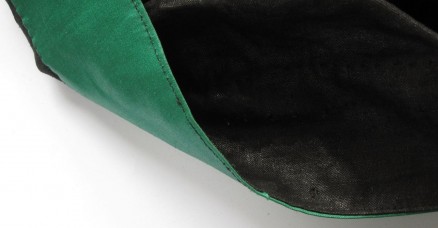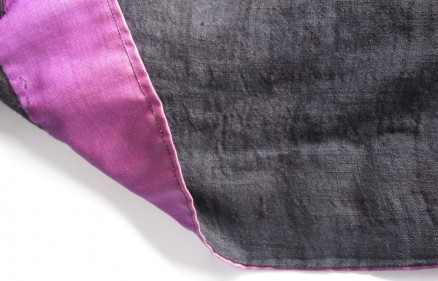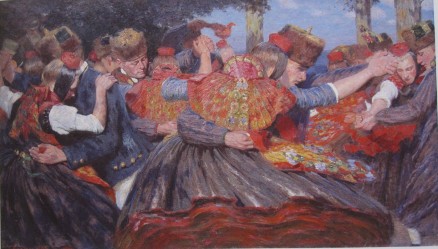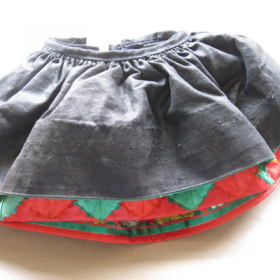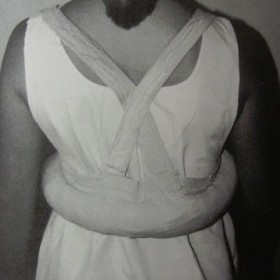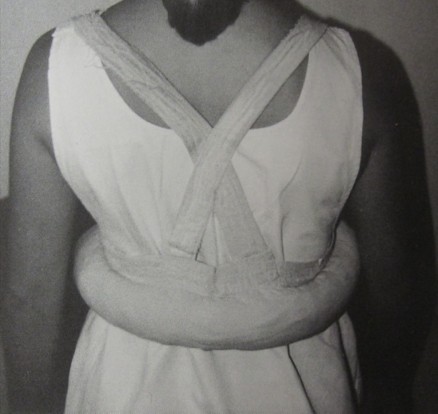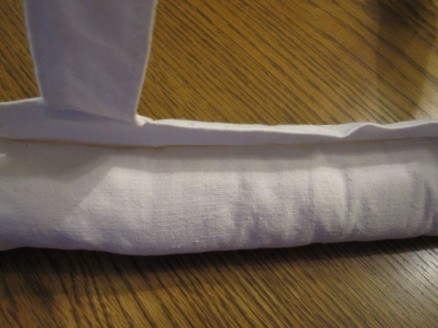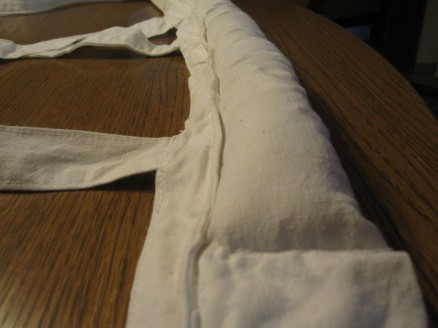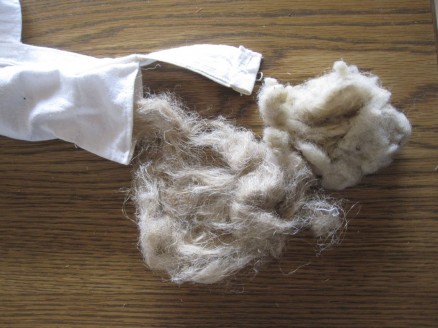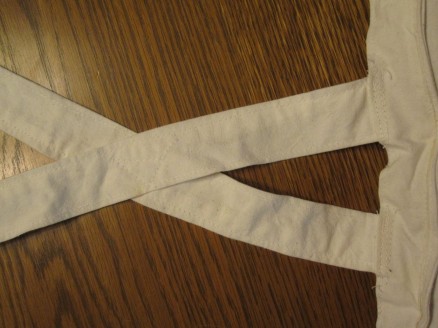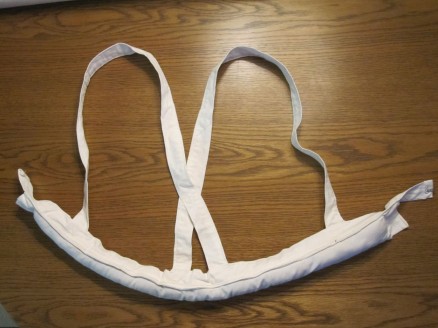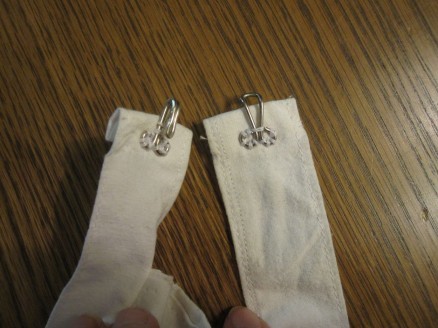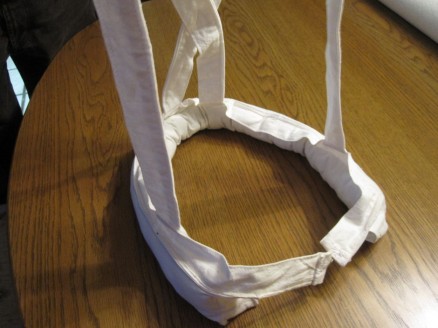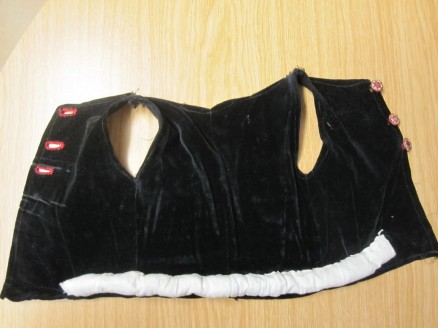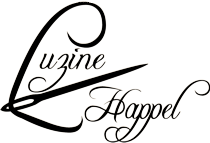For the festive costumes Schwalm women wore many skirts one upon the other. It was common that 10-12 skirts (sometimes more) belonged to one set.
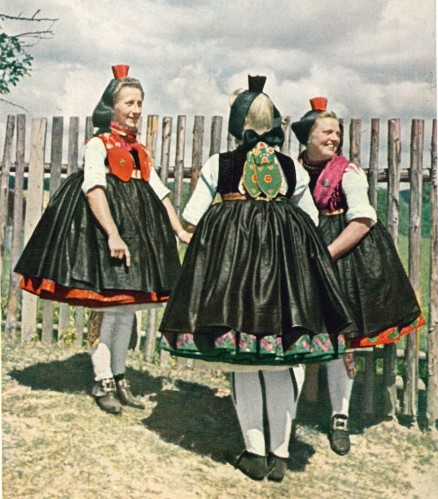
Schwalm red and green festive costumes
Schwälmerinnen beim Probtanz, Aufnahme: Dr. Andreas Scheller Nr. 1146 Gustav Mandt Kunstverlag, Lauterbach (Hessen)
More than any other element, the numerous skirts gave the Schwalm costume its special appearance. For it to be possible to wear, one upon the other, so many skirts, they had to be very full. And for it to be possible to carry the weight of so many skirts, they had to be short.
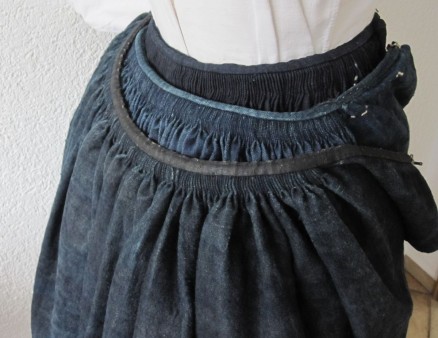
The picture of only three skirts gives an indication of the enormous amount of fabric 10-12 skirts would have had.
In the year 1941, the pastor and profound appreciator of Schwalm habits and costumes, Heinrich Metz (1897–1973) made a survey of an average Schwalm bride’s trousseau. [Source: Schwälmer Jahrbuch 2000]
Regarding the skirts he found:
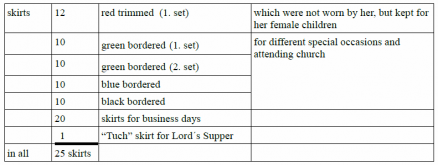
Upper class women had more, and poorer women had substantially fewer skirts in their respective trousseaus. Women of modest means often owned so-called double skirts. These were skirts with an additional piece of fabric (a strip about 15 cm high and trimmed with a border at the bottom) attached at the bottom edge to simulate a second skirt.
Most of the skirts of one set were made from “Beiderwand”. This is a linen weave fabric made of linen threads in the warp and hand-spun lambs wool in the woof. It was dyed to blue with indigo.
These fabrics were not colourfast.
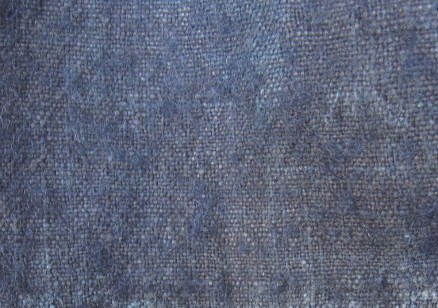
“Beiderwand” fabric, dyed with indigo
Only the skirt worn on top was made of finer and more expensive fabric. I found different details.
One source tells about fine, shiny black linen for the green costumes, another source tells about fine, shiny “Beiderwand” dyed to black for the green and blue costumes and dyed to blue for the red costume. A third source mentions “Tuch” (a fabric made of wool yarn).
The matte “Tuch” skirts were worn in mourning and to the Lord´s Supper. The shiny skirts were worn for celebrations such as “Kirmes” (village fairs) or weddings. The shiny skirts, susceptible to water spots, were not worn during rainy weather. Also it is reported that the black and shiny top skirts were worn only on kermis Saturdays and during wedding parties only up to the afternoon refreshments.
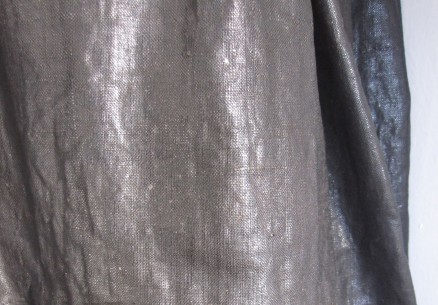
Shiny linen
“Beiderwand” and linen fabric were brought to a shine by dipping them into a special mixture made of a glue from skin leftovers from the tanners and potash. By dipping into this mixture, the fabric got both a shine and a stiffness. The shine was increased by rubbing with a special stone, the “Glänzstein”. Therefore the fabric was laid on a corrugated table and rubbed with very strong pressure. The “Glänzstein” was made of a wooden handle with an oval shaped fine-grained agate stone attached to the bottom.
In winter women wore the “Kalmuck” skirt closest to the body. “Kalmuck” was a twill fabric that had been vigorously rubbed on both sides. This treatment produced a soft and warm fabric.
For one skirt 4 meters of fabric was needed; this length of fabric was closely gathered so that the result looks like tiny pleats. (About the year 1900, five cuts of fabric 80 cm each were used, later 4 ½ cuts of fabric were considered enough.)
The waistband was fastened in the middle of the front (this area was covered with an apron later).
To the left and to the right of the middle front, sections of the fabric remained plain, the rest was gathered. To achieve an even drape, the following was done: The waist was measured and a fabric strip for the waistband was divided into 6 parts. However the width of the skirt fabric was divided into 8 parts.
For example:
A skirt has a finished waist measurement of 66 cm.
66 cm : 6 parts = 11 cm/part
So, making the skirt, 11 cm of the fabric remain plain (1 part), 44 cm (4 parts) would have been gathered, and the last 11 cm (1 part) remains plain again.
The four parts for gathering were divided in half again, so that 8 parts of 5.5 cm each were established.
The width of the skirt fabric measured 382 cm. For the two plain parts 22 cm were needed. So 360 cm of fabric remained. This was divided into 8 parts of 45 cm each. The fabric had to be divided in this way so that in the end 45 cm of fabric was gathered down to 5.5 cm.
If this division had not been made, it would be near impossible to space the gathers evenly onto the waistband.
The tiny pleats were laid and pinned. If everything fit according to the previously made divisions, the pleats were secured with Stem stitches using a thick and strong thread, from the back and about 2-3 cm from the top edge.
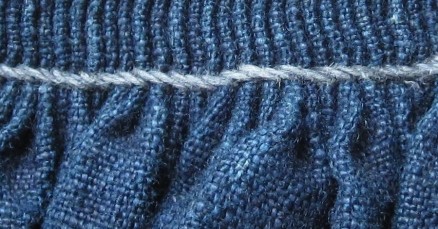
Pleat after pleat was secured with Stem stitches
Along the top edge, a fabric strip for the waistband was laid right sides together and sewn.
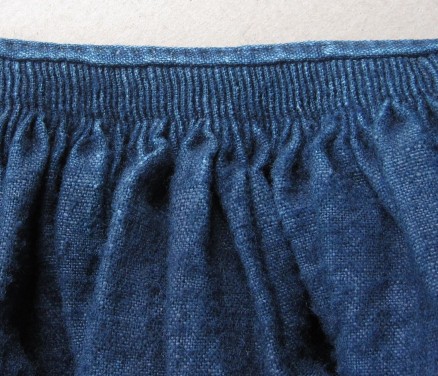
Gathering of a skirt with waistband – front side
It was then turned and secured on the backside approximately in the middle of the pleats. In this way the pleats were stabilized once more, and a waistband is attached.
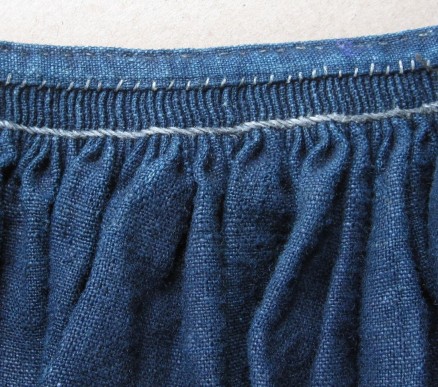
Gathering of a skirt with waistband – back side
Because adding skirt upon skirt increased the waist measurement by 2-3 cm per skirt, each skirt´s waist had to be increased accordingly.
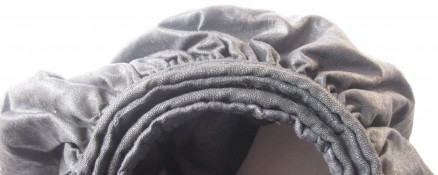
Ech subsequent skirt needed its waist measurement increased 2-3 cm
The skirt was sewn closed along the center front seam about half way up from the hem. And the waist was closed with hook and eye.
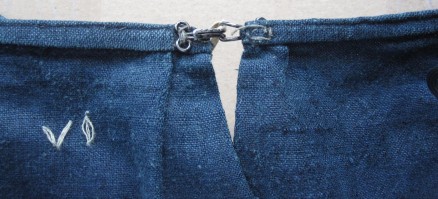
Closure with hook and eye
If, later on, there was need to increase the waists, there had to be a way to adjust the waistband.
The women solved this problem by adding small chains or bands to bridge the gaps.
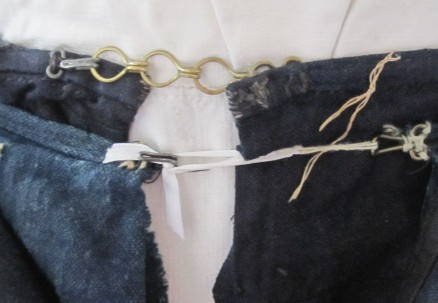
small chains or bands to adjust the waistband
The length of the skirts differed. It was not only determined by the height of the woman, but also on the range the skirt would have – that is, how far they would lie up and away from the body.
The bottom skirt would have been short enough so that the undershirt could be seen peeking from underneath about a hands width. Every additional skirt must be cut somewhat longer (although in the end it would look as though it is shorter).
Only in a few villages of the Schwalm, were the skirts’ lengths cut so that all – one upon the other – looked the same length. Usually the upper skirt fell a little above the hem of the previous skirt so that the whole magnificence of the bands could be seen.
To eliminate confusion when dressing, the skirts were numbered.
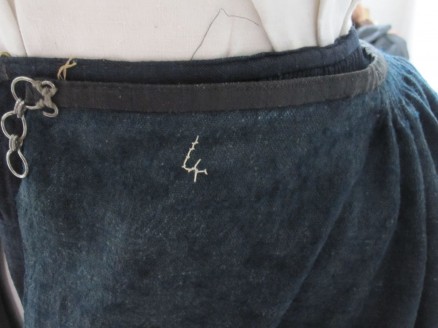
Each skirt’s “place” was clearly embroidered
It would be difficult, to establish a nice drape by hemming such sturdy fabric. So at the bottom edges the skirts were trimmed with narrow strips of fine coton fabric and often decorated with additional borders.
The skirt bands are worth their own chapter, so I will report about this subject in the future.
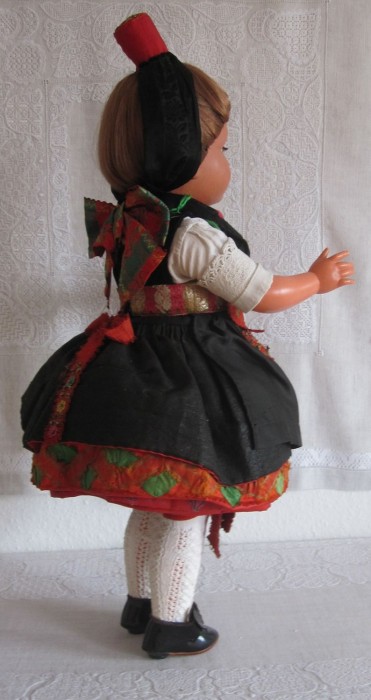 The bodices were worn over an undershirt and harness. They were slim fitting, short waisted, and did not have any closures. The sleeves were disproportionately long.
The bodices were worn over an undershirt and harness. They were slim fitting, short waisted, and did not have any closures. The sleeves were disproportionately long. Often fine handwoven linen was used for making the bodices. A bodice was composed of the following parts: 2 sleeves, 2 gussets, 1 back, 2 fronts, 2 small side sections, and 1 neckline facing.
Often fine handwoven linen was used for making the bodices. A bodice was composed of the following parts: 2 sleeves, 2 gussets, 1 back, 2 fronts, 2 small side sections, and 1 neckline facing.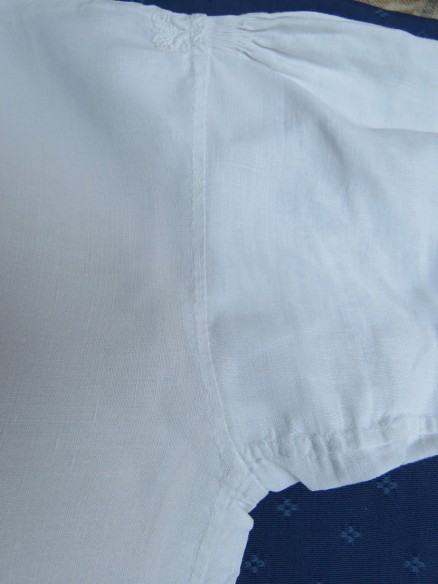 Felled seams were used for sewing together the body sections, shoulder seams, closing sleeves, and inserting sleeves.
Felled seams were used for sewing together the body sections, shoulder seams, closing sleeves, and inserting sleeves. The center front edges were hemmed, and the edges of the neckline were finished with a facing.
The center front edges were hemmed, and the edges of the neckline were finished with a facing.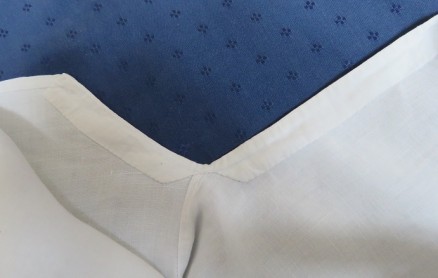 All body sections were cut to size so that a selvage was at the bottom edge making hemming unnecessary. In this way additional layers of fabric in the waist area was avoided (and we have seen already the quantity of fabric at the waist with the multiple skirts).
All body sections were cut to size so that a selvage was at the bottom edge making hemming unnecessary. In this way additional layers of fabric in the waist area was avoided (and we have seen already the quantity of fabric at the waist with the multiple skirts).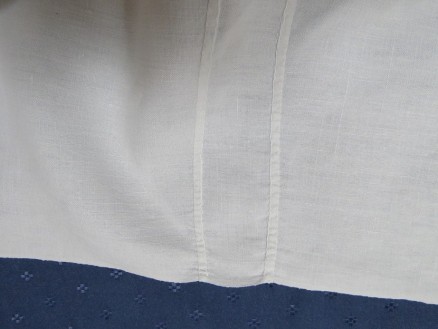 The fronts of the bodices were cut somewhat smaller than the back: so, the front edges did not reach the middle of the body.
The fronts of the bodices were cut somewhat smaller than the back: so, the front edges did not reach the middle of the body.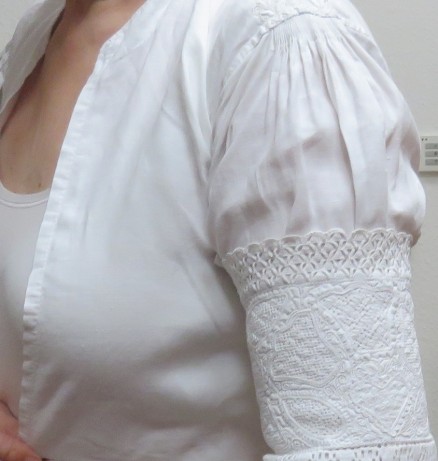 On the right front of a bodice, the initials of the owner were embroidered using coloured thread and Cross stitches. Sometimes also narrow ornaments were embroidered between the single letters of the initials. (Such charted ornaments and letters can be found in the book Schwalm Crowns.)
On the right front of a bodice, the initials of the owner were embroidered using coloured thread and Cross stitches. Sometimes also narrow ornaments were embroidered between the single letters of the initials. (Such charted ornaments and letters can be found in the book Schwalm Crowns.)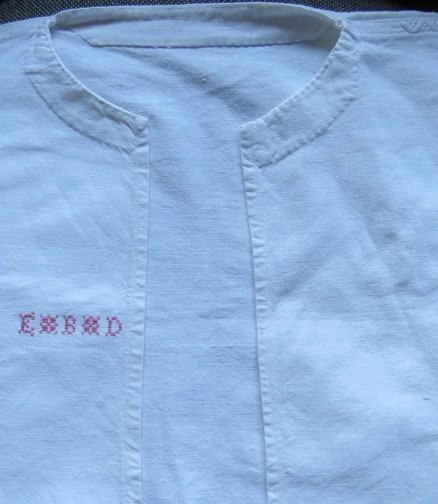 A small strip of fabric was inserted at the sides (between the front and back sections);
A small strip of fabric was inserted at the sides (between the front and back sections);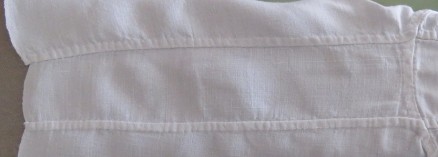 the width of this strip was the same as the widest edge of the sleeve´s gusset.
the width of this strip was the same as the widest edge of the sleeve´s gusset. The sleeves, from the shoulder, were tapered down to the cuff.
The sleeves, from the shoulder, were tapered down to the cuff.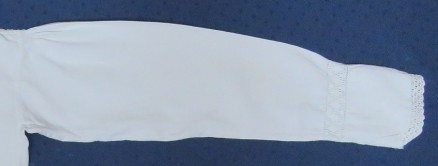 The excess width of the sleeves at the shoulders was gathered down to 4 cm.
The excess width of the sleeves at the shoulders was gathered down to 4 cm.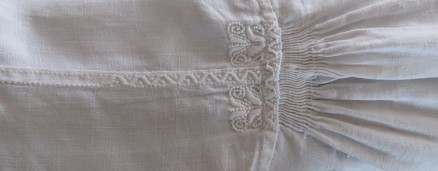 The tiny pleats were secured and stitched in place for about 1–1.5 cm with some rows of Running stitches. Curved line patterns decorate both a section of the seam adjacent to the pleats and a section of the shoulder seam. (More curved line patterns can be found in my publication Schwalm Curved Lines, Narrow Borders, and Ornamental stitches. Often additional small motifs were embroidered in the corners of the decorated seams.
The tiny pleats were secured and stitched in place for about 1–1.5 cm with some rows of Running stitches. Curved line patterns decorate both a section of the seam adjacent to the pleats and a section of the shoulder seam. (More curved line patterns can be found in my publication Schwalm Curved Lines, Narrow Borders, and Ornamental stitches. Often additional small motifs were embroidered in the corners of the decorated seams.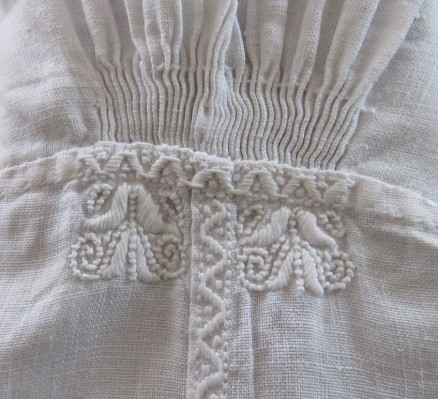 The sleeve cuffs were decorated with embroideries. These developed variously and, depending on the status or wealth of the wearer, were more or less brilliant. There was always a whitework border, a Peahole hem, and needlelace. Often there was also a needle weaving hem, and sometimes a needle weaving hem in addition to Peahole hems can be found.
The sleeve cuffs were decorated with embroideries. These developed variously and, depending on the status or wealth of the wearer, were more or less brilliant. There was always a whitework border, a Peahole hem, and needlelace. Often there was also a needle weaving hem, and sometimes a needle weaving hem in addition to Peahole hems can be found.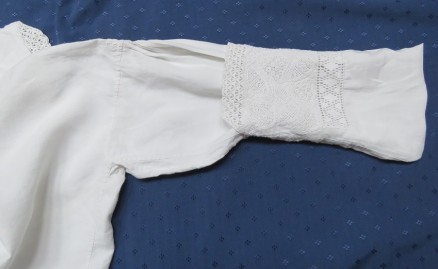 the remaining unembroidered part is folded
the remaining unembroidered part is folded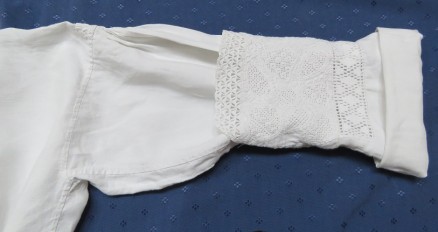 so that the bottom edge hangs around the elbow.
so that the bottom edge hangs around the elbow.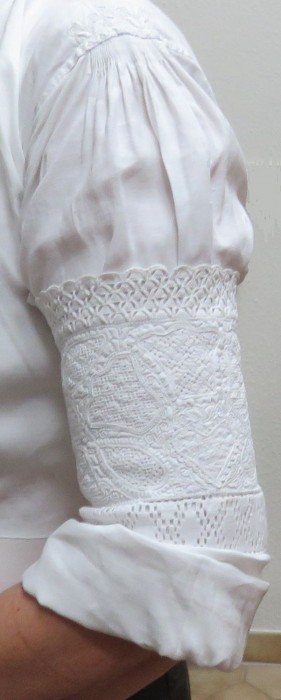 The decorations of the sleeve cuffs will be discussed in a separate article. You can read it in my next post.
The decorations of the sleeve cuffs will be discussed in a separate article. You can read it in my next post.